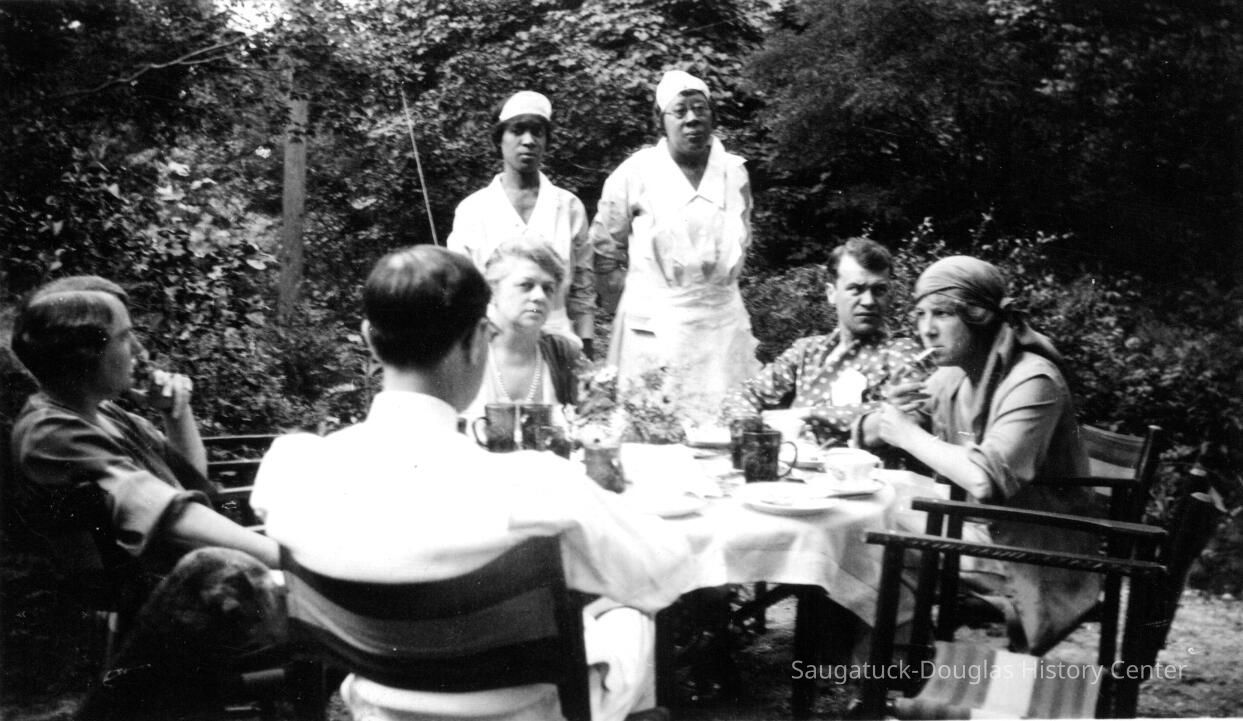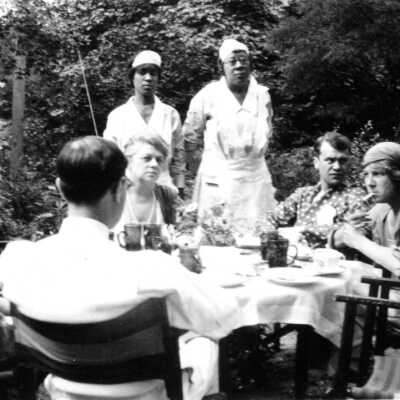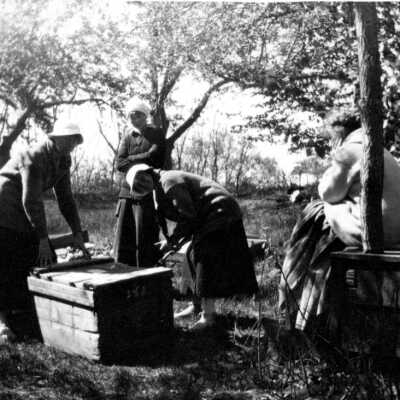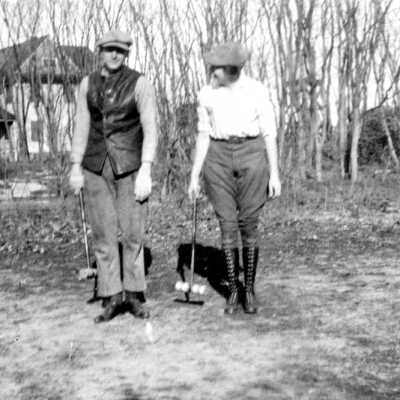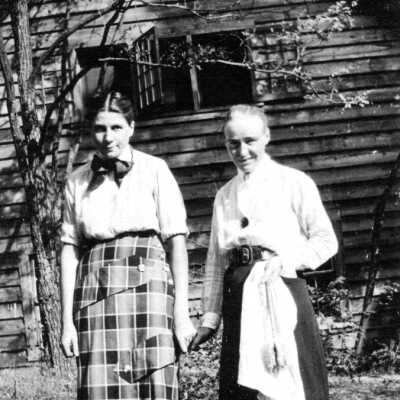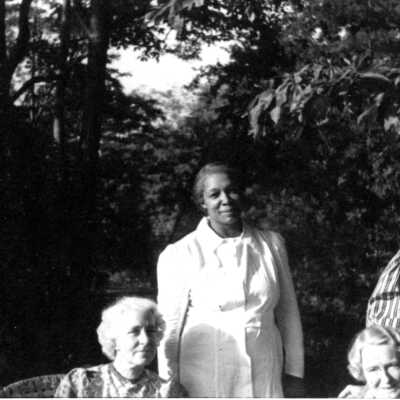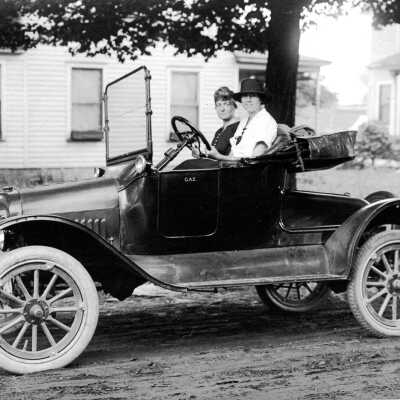Note
Status: OK
Status By: Mary Voss
Status Date: 2018-12-10Note
Florence "Dannie" Ely Hunn
A Pier Cove Designer and Architect Re-discovered.
Text from "Tuesdays at Noon" talk at Museum, July 25, 2000, by James Schmiechen
Florence Ely Hunn (born Aug. 24, 1887, died March 24, 1984, age 98) described herself as "a plain mid-west gal" but in life she was far from plain and ordinary. In fact, she was a very unconventional woman who found the Saugatuck-Pier Cove area the perfect place for the expression of much of her personal and professional life.
She was born into a farm family in Des Moines, Iowa in 1887. Her mother was Lucinda Bonine (died 1930). Her father was Ely Simonds Hunn (died 1927), making her cousin to O. C. Simonds, the well-known Chicago landscape designer and summer resident of Pier Cove. She was, through her father, a tenth generation descendant of the Mayflower settler Jonathan Brewster. Soon after 1940 her parents purchased a small cottage in Pier Cove, just to the east of the Simonds cousin's Orchard House. A photograph of her in her early twenties shows her on her horse"Bob" dressed in a cowboy outfit, with her proud father standing nearby.
At the age of 20, at her father's urging, she traveled west and became a horsewoman and a worker in mines and oil drilling fields. At 22 and 23 in 1909-1910 she attended school in Germany and France and traveled in Greece--having studied the Greek language in her Iowa school. She graduated from the University of Chicago at 24 and then continued her studies at the Chicago Academy of Fine Arts and the Art Institute of Chicago. When America entered World War I in 1917 she wanted to join the American cause overseas but instead contributed her services to Uncle Sam by managing one of her father's purebred stock farms for the production of food for the Army.
At the age of 28 she began designing building exteriors -- a passion pursued for the next 60 years. When the war was over she sought to fulfill her dream of the formal study of architecture but because architecture schools were not admitting women, she did what many other women in the same predicament did, she became an interior designer. At first she became apprenticed with one of the best known interior decorators in Chicago, and then in 1925 she opened her own shop.
Her Chicago studio and home was at 101 East Oak. She later moved the studio to 920 N. Michigan Avenue. In March of 1934 she and Frances Crumb opened a design store known as "Contemporary" at 49 Cedar Street which featured avant-garde furniture and wall coverings.
The success of this store led to the opening of branches in New York and Philadelphia. She was a frequent lecturer on interior design at the Chicago Art Institute, wrote articles for the Chicago Tribune and other magazines, and in the 1930s presided over a weekly interior design talk show on Chicago radio WMAQ. She was a founder of American Institute of Decorators -- of which she was vice-president in the 1930s. Her early interior design centered on 18th Century English and American hand 1920s "Colonial Revival") period work. Most of her clients had large apartments on Chicago's Gold Coast and homes in the hunt country of nearby Barrington, Illinois. She did some East Coast work, including the Price-Waterhouse partners' houses, in Rye, New York.
By the 1930s Florence Hunn had become one of the leading American designers. Her portrait by Wellington Reynolds of the Art Institute of Chicago, in the American impressionist manner, hung at the Art Institute of Chicago for one year. It is now in the possession of the Saugatuck-Douglas Historical Society.
What kind of work did she do and what makes an interior designer famous? With regard to interior design philosophy, her bread and butter, then, centered on creation of high class 18thcentury English and French interiors and hence she fit well into the traditional side of her time. She worked for the moneyed class, which had long dictated that the only good interior design was that which copied the 18th century. Like a good designer she hated the 19th century (she once said, "the 19th Century might readily be wiped from our memory ...") and at first appears to have had little to do with the 20th Century.
But things were changing, and Hunn took up the modernist cause in a city known in the 1920s for its design conservatism. Although keeping with the traditional world of conservative interiors was goad far her pocket book,she also went off in a different direction, advertising her work as "new designs in furniture in the modern spirit." Here we see her mimicking the anti-establishment and chic Art Deco and Art Moderne styles of New York.The New York Sun described her as "bitten with the modern desire to create entire rooms with geometric designs" in white, and in glass and mirrors. One of her new furniture designs was that of futuristic looking dining table with mirrored edges and white and gray painted chairs. One of her specialties was modem wallpaper and furniture design, and she was a pioneer in introducing Art Deco style glass molding (in green) and mirrors into room decoration, modernist tile, painted furniture, and, by the 1940s, California-inspired architecture.
Hunn's drift to the modern even showed up in Douglas in 1954, where she was commissioned to remodel the old Tara Restaurant-giving it a new entrance, iron railings, and interior murals (no record of the Tara images exists), as well as in the design of two ranch-style lake shore cottages.
After World War II, responding to new needs far new housing formats, Hunn was one of the organizers and designers of the influential "At Home In America" show in Chicago in 1954, a trade show that pioneered in the introduction of modern house design in the United States (she used Baker furniture in the living room).
Like her professional life, Hunn's private life was far from ordinary, and she appears to have been able to play to both the traditional social world and a more bohemian and non-conformist world at the same time. Most important, it appears that her beloved Pier Cove was important in providing a place for her relationship with her life-long companion, Mabel (known as "Jims") Warren, a physical therapist at the Washington School for Crippled Children on Chestnut Street, Chicago.While much of her design work suggests that she might well be an ancestor of the famous Reverend Brewester of Massachusetts,photos from the time suggest that Dannie and Jims combined the elegance of traditional 18th century interiors with what at-the-time must havebeen fairly eccentric and non-conformist behavior. Florence herself was known as Dannie, and thus the two of them were known in Pier Cove as "The Girls" - and were not accepted by some Pier Cove residents in early years.The original 1858 section of the house (she preserved the wonderful crooked floor and the tilting interior doors) was the girls' smoking room, called the"Cardinal Puff Puff Room." Just beyond this was a tiny room with a large copper sink, and which served as the cottage barroom.
Jane Badamo recalls that when she was ten she first met Dannie who was wearing one green shoe and one red shoe. Jane was sent off to the beach, but she recalls saying to herself "I gotta get to know this person." One photo of an outdoor dinner table shows Jims with bobbed hair and Dannie, with a scarf around her head gypsy style and a cigarette in her mouth, obviously the center of the conversation, and with two black servants in white uniforms standing behind the gathered table guests.
Costume and play-acting in a number of photographs from the 1920s and 1930s suggest that the pair had a great sense of incorporating theater into daily life. A frequent guest was Gladys Stempfel, and known Saugatuck friends were Jim Dillon and Bob Schwartz, known as "the Boys" (they owned the Bayside Building in Saugatuck and had a shop there called "S&D Design") and Shirley Dorchner and her companion Liz, of Holland, who had a cottage on the Douglas lakeshore just to the north. The gang was well known for its drinking and golf (playing golf into their 90s). The story goes that Schwartz's mother once asked him if he knew any nice girls. We can only surmise the answer.
Such non-conformist social expression among the wealthy artistic intelligentsia was not unusual for the age. It is well documented that certain women, such as the ex-patriot Americans Gertrude Stein and Alice B. Toklas in Paris and members of the Bloomsbury circle in London, including writer Virginia Woolf and painter Vannesa Bell, provided notorious models for the nonconformist bohemian life. It would be interesting to know where Dannie went in her two-year stint in Europe, who she met and the ideas she acquired. One of the best known interior designers of the age was Eileen Gray, an Irish expatriate living in Paris--- who also moved into design because she could not get into architectural school. From the social side, it was, after all, the "roaring Twenties" and Europe was the place that roared the loudest. The picture of Dannie and Jims at Pier Cove suggests that what was happening in Paris, London,and Berlin did not exist in geographic isolation. Pier Cove rocked.
While the rich and famous of Chicago and New York provided her with her interior design arena, it was the Pier Cove-Saugatuck area which gave her the opportunity to practice architecture and landscaping. It is unfortunate, however, that the record of much of her architectural work has been lost. She carried out a major restoration of one Saugatuck's most historic and architecturally significant houses, and designed four new houses. But the centerpiece of her architectural world was her own cottage. In about 1917 "Dannie" and "Jims" acquired a small and derelict old Pier Cove worker's house of 1858 for earlier)[2234 Lakeshore Drive, Fennville] , which, because of its size and simple charm, was known as the "Doll House." Beginning about 1915 and for nearly 70 years following, they built, re-built,added on, and re-invented a marvelous lakeshore home and garden. Outdoors, they planted dwarf apple trees, transformed nearby tennis courts and the hilly terrain surrounding their home into a series of English garden rooms, with flagstone walks, open areas for outdoor croquet and luncheon parties, and grand vistas of Lake Michigan.
The house itself was an expression of her traditional style with a number of radical twists. The original worker-cottage portion of the house already had an addition. Over the years it was wrapped on other sides with porches, and then in 1937 it received a large American farm and Arts and Crafts-like addition designed by Hunn. This addition was placed so that as the visitor approached the house, the old 1858 section,with its door framed by lovely old benches and covered by an arbor, stood out like a chapter in an old story. By attaching the new to the old Hunn preserved one of the few remaining structures from the"olden days" when Pier Cove was a lumber and fruit exporting village.For materials, she replicated the old local tulip wood clapboard for the siding and found local craftsmen to produce hand-made nails. The interior felt like a mix of American farmhouse primitive (with slanting floors in places) and English cottage complete with wonderful 18th Century furniture from Hunn's collection. A very fine American Prairie Style studio-garage was erected about 1928. The board and batten walls of the old and the new structures fit in well alongside the ancient orchard that surrounded the house. Her friend Mary Miller carefully preserved her Pier Cove estate and gardens until Miller's death in 1999. Unfortunately, new owners destroyed the original (1858) portion of the house in the spring of 2000, and the additions were moved away. The gardens have been replaced.
In her other architectural work Dannie also combined the traditional and classical with contemporary and sometimes radical forms and materials. The fine Italianate Martel house (345 Grand Street,Saugatuck), restored for a Chicago industrialist, was returned to its original glory, but with the rear of the house expanded and modernized to meet the needs of her client who wanted a place to paint.
In many of her works, interior and exterior, she made extensive use of various kinds of tiles. For example she designed the ceramic tile exterior walls for two of Chicago's most prominent southside skyscrapers of the time, the Naragansett and Powahattan buildings (circa 1925) along Chicago's South Lakeshore Drive (1640 and 4950 Chicago Beach Drive). But her genius with the is best seen in her most accomplished building design, the Jordan-Porter "Tonawanda" cottage in Saugatuck, in 1927. This is probably the most radically designed cottage of the age in this area. Using dark brown glazed brick as structural blocks, this unusually tall cottage with gigantic windows, is perched high on a bluff overlooking the Kalamazoo River and Saugatuck's Lake Michigan harbor entrance.The structure is interesting because it merges a rather traditional Arts and Crafts cottage with a historic English Tudor style, but with a modernist use of glazed bricks, over-sized divided-light iron casement windows, and an open plan interior. It has been described by its present owner as having a rather monastic feel. Today it remains a seasonal structure because the owner does not wish to disturb the original scheme.
In conclusion we may say that Florence Dannie Hunn was truly an extraordinary woman. There is no doubt that she was a remarkable interior designer as well as a very interesting architect in an age when men controlled both professions. Equally important, she managed to fashion an interesting and productive non-conformist private life for herself and Jims. Pier Cove was her sanctuary in a way not unlike it was for O.C. Simonds and other neighbors. Amidst all of this was a sort of wonderfully eccentric generosity and sense of humor. It is told that when she finished the Curtis Cottage in Pier Cove the Curtises were abroad, so she decorated it in the accessories she thought the Curtis's might like but not able to afford. She priced them individually, then had an open house during which the guests were encouraged to purchase them as house-warming gifts.
We all would have liked to have met the lady with one green shoe and one red shoe.
The Saugatuck-Douglas Historical Society has recently received a bequest of the papers and photographs of Florence Hunn. This collection includes a number of photo scrapbooks, professional photographs of design work, and writings, some of which center on Hunn's life at her cherished Pier Cove cottage. Also included in the gift, is a large oil portrait of Hunn by the well-known Chicago artist, J. Wellington Reynolds. The acquisition was initiated by members of the Society in conversation with Mary Miller who inherited the Hunn cottage, and then by way of Ms. Miller's estate with help from Grace Walz. The Society is indebted to the family of Mary Miller for their generosity.